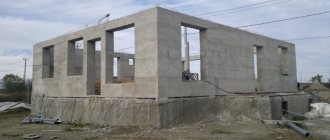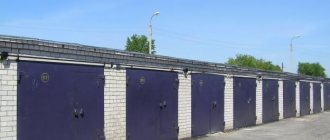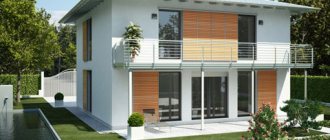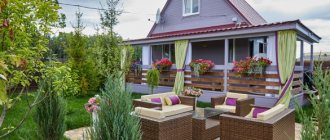January 6, 2021 GetHom expert 79,036
In this article we will consider the question of which floor is better to live on for human health and safety. When buying an apartment in a new building or an old building, you always have a choice of floor. But few people know to which floor the exhaust gases of cars rise, from which floor the firefighters will rescue you, where the cleanest air is and the best environmental parameters.
We will analyze the pros and cons of living on each floor of a multi-storey building and in the end we will determine which floor will be the best to buy.
We will evaluate floors based on several parameters:
- Fire safety
- Ecology
- Health effects
- Resale price
Floor and fire safety
Few people think about fire when buying an apartment, but fires in residential high-rise buildings do happen and are not uncommon. It is better to know in advance how high the fire escape reaches and from where you can be rescued. This information can save your life in a dangerous situation.
The longest fire escapes in Ukraine
According to firefighters, in Ukraine there is only one 90-meter ladder that can extinguish fires in high-rise new buildings. It is located only in Kyiv and will reach the 20-24th floor. In other million-plus cities there are no such stairs.
In the best case, there is one 50-meter ladder for the entire city that can extinguish a fire on the 12-13th floor of a residential building. This is the maximum height from which you can be rescued. But it’s too early to rejoice.
At best, there is only one such car for the whole city and it will take about an hour to get to you. Provided that at this moment it will not be used and will not get stuck in a traffic jam. During this time, not only the entire apartment will burn out, but also the upper floors of the building. Therefore, all floors from 10 to 13-14, although they can be saved, are in danger.
How to extinguish a fire on the 22nd floor of a new building
This is a well-known case in Odessa, when a house in the Gagarin Plaza residential complex burned down. The fire occurred on the top floor and the fire quickly spread throughout the entire façade. In Odessa there is simply no equipment capable of extinguishing such tall buildings. All floors above 12 are potentially very dangerous in case of fire.
The only way to escape on the upper floors of tall new buildings is a helicopter, but you understand, firefighters can only dream of a helicopter. This type of equipment is not used by firefighters. The fire in Odessa took 5 hours to extinguish. 80 percent of the apartments' facades burned down.
What equipment do firefighters have?
Firefighters commonly use equipment for extinguishing fires on floors no higher than 9. These are 30-meter ladders of fire trucks. In this case, the car will be able to arrive within 15 minutes and you have a great chance of surviving and remaining unharmed. The fire will be put out, and you will be able to go down the fire escape.
Conclusion which floor is better in case of fire
The best floor in case of fire in your house will be up to 9 inclusive. At least there are fire trucks in your area that can arrive quickly. Anything higher than nine can already create difficulties for firefighters.
And this is in ideal conditions, because usually our yards are filled with cars and the fire escape stretches from a long distance. So the 9th floor can also be potentially dangerous.
Radon
Sources. Radon is a naturally occurring radioactive gas that can reach the surface of the earth in areas where there is a lot of granite rock in the soil. Radon is colorless and odorless, so it is impossible to determine its presence in an apartment without special equipment. Potentially dangerous areas include the Leningrad region, Karelia, the Kola Peninsula, Altai Territory, the Urals, and the Caucasian Mineral Waters region. If you live in a disadvantaged area and begin to notice that your health has suddenly worsened, just in case, it makes sense to check the radon content in the air of your apartment. Finding a company that will measure the concentration of dangerous gas is not difficult. In addition, you can contact the SES, but such a service, as a rule, is also paid.
Who is at risk? Radon is heavier than air, so if the foundation is poorly insulated and basement ventilation is poor, radon can accumulate in the basements of residential buildings and penetrate into the apartments of residents on the lower floors. Old buildings are especially dangerous in this regard - over time, cracks may appear in the foundation, through which radon escapes into the basement.
Impact on health. Radon is a dangerous carcinogen. An increase in the level of this gas is the second most important risk factor for developing lung cancer (smoking comes first).
Harmful premises. What dangers await us in the apartment Read more
How to protect yourself. The only way to protect yourself from radon penetration into your apartment is to insulate the basement and install a ventilation system in it. Therefore, if the examination reveals an excess of radon levels, you need to contact the SES and the management company of your home. However, such cases are not very frequent. Even at the stage of laying the foundation, specialists check the possibility of radon escaping from the soil and provide measures to isolate the foundation and basements, and design a ventilation system taking into account the possible accumulation of gas.
Choosing a floor from an environmental point of view
The influence of ecology on human health is undeniable. The main sources of air pollution in cities are automobile exhaust gases and smoke from industrial chimneys. You need to be very careful when choosing the floor of your apartment to avoid the consequences of polluted air.
Of course, everything is a little arbitrary, because the houses have different ceiling heights and different locations of the house itself relative to factories and highways. In any case, the 1-2 floor near a forest park without roads will be better than the 7th floor near a highway with trucks. But still.
To what floor do the exhaust gases rise?
The closer the apartment windows are to the road, the more damage the exhaust gases cause. But the general background from exhaust gases pollutes the city air. Therefore, it is considered that the most dangerous floors are from 1 to 3.
On the third floor the concentration of harmful substances is maximum. Only light connections reach the 4th-5th floor. Exhaust gases do not rise above the 5th floor; they settle in the form of dust and dirt along highways and on city streets.
Smoke from factories and enterprises
Smoke from factories, thermal stations and gas-burning enterprises is no less harmful to humans than car exhaust gases. Smoke and combustion products from the pipes will be concentrated from the 8th to the 16th floor, depending on the nature and density of the gases.
The further away the polluting factories are, the better the composition of the air around you will be. Housing on the 7th floor near a thermal power plant will be significantly worse than on the 12th floor near the sea.
On which floor is the air cleaner?
The cleanest air is considered to be on floors above the height of the exhaust gases. This is 5 and above. But if we take into account the smoke from the chimneys of factories, then it is better to give priority to floors from 5 to 7, as well as from 16 and above. The higher the floor, the less dust and impurities there are in the air. Therefore, the cleanest air will be on high floors.
Contaminated air
Sources. About 80% of all pollutants end up in the air due to vehicles. The combustion products of automobile fuel contain oxides and dioxides of sulfur, nitrogen, carbon, as well as benzopyrene. The black “soot” on the windows of houses located near roads is nothing more than dust that is formed from tires rubbing off on the asphalt.
Article on the topic Stuffiness, heat, July. How to freshen the air in an apartment
Who is at risk? Since all of these pollutants are heavier than air, those living on lower floors suffer from their exposure. Only in hot weather, when the asphalt heats up, can harmful substances rise to the middle floors due to rising currents of warm air. Allergy sufferers living on lower floors may also be bothered by high levels of plant pollen in the air.
Impact on health. Air polluted by exhaust causes respiratory diseases, allergic reactions, and can act as a carcinogen.
How to protect yourself. Open windows when the air is still fresh - early in the morning or late in the evening. Do not ventilate the room during peak hours. The best time for ventilation is immediately after rain.
In addition, there are now many devices on the market for purifying the air in an apartment - from home air washers to rather complex systems where a hole is drilled in the wall and a cleaning unit is placed in the apartment. Through a pipe with a valve that goes outside, the outside air enters a multi-stage filtration system and is cleaned. The cost of such systems is comparable to the price of a conventional air conditioner - about 20-30 thousand rubles.
Click to enlarge
Floor and human health
Man has lived for centuries in buildings at a low altitude from the ground. Only recently has high-rise construction become popular. And doctors are already very concerned about this. People need a certain level of the earth's magnetic field. And if the natural value is violated, well-being may worsen.
In Europe, they are trying not to use high-rise construction for residential apartments at all. High-rise buildings are used as prestigious offices. And people live in houses up to 7 floors high and below.
In Ukraine, high-rise buildings are popular due to high earnings from the same built-up area. Why build 7 floors when you can build 25 and make more money.
The influence of the earth's magnetic field
Every third person suffers from claustrophobia and agoraphobia. This is a fear of closed and open spaces. The emotional state may change if you live on the upper floors of high-rise buildings.
These problems arise because the body senses a low magnetic field and a high position above the ground.
The body perceives this as a violation of the natural position and strives to go down. Due to the fact that it is difficult for the body to relax and there is no feeling of safety, discomfort and a feeling of fear arise.
If a person spends a lot of time in a weak magnetic field, then immunity and performance decrease. The activity of the cardiovascular and autonomic nervous systems may be disrupted.
Each material has its own percentage of geomagnetic field attenuation. Concrete weakens by about 10%, brick by 7%, and wood by 1%. The safest from this point of view are wooden houses. The less the magnetic field is weakened, the less stress and stress for the body.
Wall thickness
In multi-storey buildings, the thickness of the walls decreases towards the top of the building. This is done to make the top of the structure lighter and more stable. The difference in the thickness of the walls on the first and 20th floors is significant, so audibility increases.
And the greater the audibility between neighbors, the less the feeling of privacy and comfort. You won't be able to feel alone in your apartment. The noise of your neighbors will be heard and they will be able to hear you just as well. This may cause more negative emotions than on lower floors with thicker walls.
Microvibrations of the structure
Due to the thickness of the walls, microvibration appears on the upper floors. The vibrations of high-rise buildings towards the top of the structure are 3-4 Hz. This interval corresponds to the vibrations of human organs and can pose a great danger. Since during resonance, the human body experiences a depressed state and a feeling of anxiety, even to a state of horror.
Electromagnetic background
All electrical appliances in the house have their own background and outgoing radiation. Reinforced concrete structures do not transmit electrical waves well. They circulate throughout the apartment and are transmitted to higher floors.
The higher the apartment is in the building, the higher the overall background. It is believed that it is for this reason that residents of high floors more often have problems with headaches and poor health.
Best floor for health
The closer to the ground, the better. Man lived like this for thousands of years, and he got used to this state. Doctors call a comfortable floor for living from 1 to 7-8. Anything higher is no longer so comfortable for a person to endure.
On floors above the seventh, the magnetic field decreases, and microvibrations increase and on the last floor of the building they acquire maximum deviations from the norm. Some people may not feel all this, and some people will not feel comfortable. You need to look individually.
Features of floors, pros and cons
Each floor of a residential building has its own characteristics, advantages and disadvantages, which developers and realtors are well aware of. Let us share these details with our readers.
Pros and cons of living on the ground floor
The first floor is attractive mainly for sedentary people . Living here is the most fire-safe, you don’t depend on the condition of the elevators, you don’t pay for the number of floors upon delivery, you can easily take your stroller for a walk, and it’s not difficult for an elderly person to go outside.
For many people, these factors, combined with the lower price of such apartments, become the main criteria that incline them to choose housing on the ground floor.
Are there any downsides? Of course, it’s not for nothing that apartments on the first floor are sold at a discount.
So, let's talk about the disadvantages:
- Apartments located on the ground floor are most often broken into by burglars.
- They have the highest noise levels, polluted air, basement dampness, and mosquitoes in the summer.
- Because of the trees, there is little light in the apartment, so residents have to spend most of the day in the light, which is harmful to the eyes and unprofitable financially.
According to statistics, the first floor turns out to be unattractive for most Russians. The discount on such apartments reaches up to 20% in some cases.
Features of the second floor
The second floor is not much different from the first, especially in new buildings . After all, on the first floors of new buildings there are cafes, shops, and offices. Therefore, all the disadvantages of the first floor automatically go to the second floor.
Thus, the pros and cons in this case are repeated, but the price for apartments on the second floor will be slightly higher.
Features of the third to seventh floors
We have united these floors under a common slogan - the golden mean . Mid-rise apartments are in high demand.
An elevator breakdown is not yet perceived as a disaster, and in the event of a fire, the chances of rescue are quite high.
Floors four to six are the safest from an environmental point of view. The noise level is low and the air is cleaner.
Eighth – tenth floors
Floors 8, 9, 10 are usually preferred by young families . Everything in the new buildings here is well organized: the apartments are bright, spacious, you can hardly hear cars.
If the elevator is broken, you can walk – “it’s good for your health”! And what a view you can see from the windows of some high-rise buildings!
From eleven to sixteen
The upper floors have their own characteristics . It’s already problematic to get here without an elevator, and going down is not a pleasure either.
There are no smells from exhaust gases at such a height, but smoke from the chimneys of nearby industrial facilities can be smelled well.
Constant vibration on the upper floors, according to doctors, worsens well-being, provokes headaches, depression, and frequent mood swings.
Sixteen +
Houses with 16 or more floors are being built more and more often today . And apartments located practically in the “heaven” have their own buyer, although there are plenty of disadvantages here.
Let us further highlight the pros and cons of living on the top floor. Let's start with the disadvantages, since there are more of them. The main risks and threats here are elevator breakdowns and fire. In the latter case, there will be very little chance of escape, since the maximum length of fire truck ladders is 75 m.
A broken elevator, of course, is not a disaster, but it also creates significant difficulties not only on the ascent, but also on the descent. Window cleaning cannot be done without calling a cleaning company.
Pros:
- in case of an emergency, assistance can be provided from the roof;
- on the top floor you can install a fireplace or add part of the attic (in a new building);
- There can be a beautiful view from above.
Study in Switzerland
In 2013, scientists from the University of Bern in Switzerland published a detailed report in which they analyzed the impact of the floor of residence in high-rise buildings on human life.
They analyzed the mortality statistics of the Swiss depending on which floor they lived on. The analysis was carried out on the basis of the 2000 and 2008 censuses with a sample of one and a half million people.
Scientists' conclusion
If you live in a city, with vehicles and traffic flow, then residents of the first floors have significantly more risks compared to residents of higher floors. The mortality rate decreases with increasing altitude of residence.
If we compare the 1st floor and the 8th, the conclusions are as follows: on the first floor the mortality rate is 22 percent higher. People are 40% more likely to die from respiratory diseases, 35% more likely to die from heart failure, and the risk of lung cancer is 22 percent higher than for a resident of the eighth floor.
From this report we can conclude that exhaust gases are extremely harmful to humans and living on the ground floors in the city is not the best solution.
Overview of floors by parameters
Lighting
The higher the floor, the more light will enter the apartment. The first floors of buildings are usually dark. Even during the day there can be discomfort due to lack of lighting. You'll have to turn on the light bulb. Access to sunlight is blocked by trees and neighboring houses. If you want it lighter, then you need to choose floors above 5.
Dust and insects
Of course, there is more dust on the floors closest to the ground. The first one has its maximum quantity. And as the number of floors increases, the dust becomes less and less.
And with insects and mosquitoes, it’s just a common myth that there are no mosquitoes and flies on the upper floors. Mosquitoes are everywhere and the 15th floor will not save you. It's just that the higher the floor, the stronger the wind, making it harder for mosquitoes to fly.
Sound
In terms of sound comfort, it is impossible to identify a clear leader. Noise from the street can be heard everywhere. It’s just that if on the first floors it will be noise from passing people, then on the last floors it will be disturbed by the wind and more specific noises.
And the cars, the road, the playground, the music from the summer cafe, everything is heard almost equally on all floors.
Elevator
Everything is clear here. If any people can live on the 1st floor and a power outage does not bother them in any way, then going up to the 15th floor without an elevator requires good physical preparation. The pulse goes far beyond normal limits.
You'll have to stop and take a break. Mothers with strollers will not be able to get up at all. It is very difficult to drag a stroller to the 25th floor alone with a child.
Lifting materials, equipment and other large items to a high floor will be a real feat for you. Things don't always fit even into a freight elevator.
Try bringing a voluminous sofa, large appliances or linoleum to the 20th floor without an elevator. Loaders charge for lifting to each floor separately. The higher, the more expensive. And even for them it will be extremely difficult to drag a large item to the top floor.
View from the window
Here, of course, the highest floors win by a wide margin. The panoramic view is highly valued and pleasing to the eye. Sunrises and sunsets will be your constant companions. But is it worth paying for it at the cost of the possible problems described above? It’s up to you to decide.
Noise
Sources. Cars and public transport. An additional unfavorable factor may be the presence of a store on the ground floor of the house. Air conditioning units that cool retail outlets and ventilation systems often end up at the second floor level.
Weather in the house. Choosing air humidifiers Read more
Who is at risk? Residents of the lower floors suffer from increased noise levels more than others. The least sounds reach the windows of the upper floors.
Impact on health. Reduces hearing and negatively affects the state of the nervous system.
How to protect yourself. The most effective means of protection is double-glazed windows with a high level of sound insulation. Nowadays you can find plastic windows equipped with special valves. By opening such a valve, you can ventilate the apartment without disturbing the sound insulation characteristics of the double-glazed window. Upholstered furniture, carpets, thick curtains, although they have the ability to absorb noise, can rather protect against sounds that are heard inside the house (from neighbors’ apartments, from the elevator shaft), rather than coming from the street. However, this arrangement of the apartment also reduces the noise load on the residents.
Click to enlarge
Floor and selling price of the apartment
Few people like the first floors, so they are usually cheaper in price and more difficult to sell. The price of an apartment on the ground floor, compared to the 5th floor, will be 10-15% lower. For some this is a big plus.
The first floors are purchased by people of retirement age and disabled people. It’s convenient for them that they don’t have to walk if the elevator is turned off, and the cost is cheaper.
Related article : Real estate lawyer in Odessa
On the first floor there is the most noise, the cleanliness of the air is not pleasing, dampness and cold come from the basement. Unlike the possibility of fire on the upper floors, problems on the ground floor worry residents every day.
Top floor
Apartments on the top floors also always do not please buyers. To sell you will need to offer a good discount. This is the same 10% of the price of the average floor. On the top floor you will be disturbed by noise from the elevator and water pumps.
As well as possible problems with the roof and walking to your floor in case of a power outage. Apartments on the top floors are not as valuable as those in the middle of the building, so these apartments are difficult to sell.
Duplex apartments
Developers often offer to combine the top floor with the other floor and make a two-level apartment. In this case, you will also need to worry about water leaks from the roof.
Since you occupy the floor that goes directly to the roof. The height of the technical floor is usually 2.10, and not 2.60 as in ordinary apartments. Therefore, the technical floor is poorly suited for a comfortable life.
Attic
Developers often try to sell not only the last residential floor in the house, but also the attic space. As already mentioned, the ceiling heights there are lower than in ordinary apartments. In addition, there is no elevator to the attic.
You will need to walk up the stairs from the top floor to your home. Housing under a roof in the attic area is called an attic.
There is also a problem with documents. Since initially this is a utility room and you are not buying an apartment, but an attic, you will still have to spend money and time to legalize your living space. This can cost anywhere from several thousand dollars. Because of this, housing on the attic floors is valued even lower than on the last residential floor of the building.
Penthouse
Penthouse is a fashionable name for an attic in our country. But if you call an apartment on the top floor an attic, then no one will buy it. It is because of this that Ukrainian developers use the word penthouse in their new buildings and inflate the price.
In fact, a penthouse is a full-fledged house that occupies the entire top floor of the building and has its own elevator and terrace. This is your own private house on the roof of the building. You can arrange a winter garden, a swimming pool, a gazebo.
Due to the exclusivity of such housing, prices may be higher than in the rest of the new building. But in Ukrainian realities this is usually the same top floor of a building, but with access to the roof and for a higher price.
It retains the problems of all the upper floors, but has its own area in the form of a terrace. It's up to you to buy or not. Housing, like an attic without documents, is specific. Not suitable for everyone and not easy to sell.
Which floors are the most popular on sale?
Middle floors of the building. Floors 4 to 8 are in greatest demand for sale. They sell out first. They are in demand both on the secondary market and in new buildings. Investors in new multi-storey buildings first buy the 5th-7th floor and only after that the 4th and 8th. They are close to optimal, so they are also in demand.
Related article: How to buy an apartment without intermediaries in Ukraine
1-3, 9 and above are no longer so attractive for life and because of this they lose a little in value. If the last floor loses 10% of its value, then all the previous ones are proportional to the distance from the optimal average floors in the house.
This means that the 11th floor will cost a little less than the average 7-8 out of 16. But everything has its buyer.
Which floor to choose when buying an apartment
Which floor is better to live on? This is a question that many people have faced. In new buildings, similar apartments on different levels usually cost almost the same. But when buying housing on the secondary market, prices depending on the floor can vary by 10–15%.
Let's consider the main factors affecting the quality of life in connection with the height above the surface. They can be grouped into the following main categories:
• safety;
• comfort;
• ecology
Safety
A characteristic feature of the first floor apartments is bars on the windows. The lower levels are the most dangerous from the point of view of possible penetration into housing. It is much easier for a thief to get into an apartment on the 1st floor than on the 6th. Previously, there was even such a thieves’ specialization - “window makers.” Criminals of small stature and puny build managed to enter the apartment right through the window!
Even if all the windows are tightly closed, it will not be difficult for a professional swindler to open the frame with a screwdriver or chisel. Therefore, residents of all first floors, and often the second and even third floors, have to install bars. After all, very much of the building’s design allows easy access to these levels through canopies, balconies and other architectural elements.
There is a certain danger of penetration into the apartment on the highest floors. Thieves can get into the home here through the roof, technical floor, balconies, etc. However, the degree of risk here is less than on the lower floors. And the safest ones are apartments on the middle levels.
Fire safety
Subconsciously, any person understands that the lower he lives, the greater the chance of surviving a fire. In reality, the danger on the first floor may be slightly higher than on the second or third - due to the already mentioned bars on the windows. Although usually residents of the lower floors manage to leave burning buildings in time. It's worse for those who live high. The fire can cut off their escape route up the stairs. And you won’t jump down from a great height either.
The only hope for many residents of the upper floors in the event of a fire is the arrival of rescuers. The fire-fighting crews of the Ministry of Emergency Situations have special equipment with retractable ladders. However, the height of such stairs is extremely limited. In most cities, their maximum dimensions are 30 meters. This is approximately the 9th–10th floor. In some cities, stairs extend 50 meters, up to the 17th floor.
In Moscow there are several telescopic lifts with a height of 90–100 m. They are able to reach the 27th and 33rd floors. Considering the capital's distances, you shouldn't hope for their quick arrival in the event of a fire. In addition, their work at high altitudes is very limited by weather conditions.
From a fire safety point of view, all floors above the 9th are most dangerous. Your city may simply not have stairs of the required length. And if it is available, the crew needs time to get there.
Comfort
Here we can highlight several main criteria related to the floor of residence.
Noises and extraneous sounds
The worst sound environment is on the lower floors. Here you can better hear traffic and conversations on the street. If there are benches under the windows, then noisy companies can disturb sleep even at night.
The door may slam at the entrance, and the neighbors are constantly walking up and down the stairs, leaving and arriving in the elevator. Mothers rattle their strollers, cyclists rattle their vehicles.
On the highest floors there is less sound from the street or courtyard. But the walls here are thinner than below. Therefore, it is much better to hear what is happening with your neighbors. Plus, on the top floor you can clearly hear the operation of elevators and pumps.
In general, in terms of acoustic characteristics, apartments in the middle of the building, approximately 4–7 floors, are preferable.
Illumination and sun rays
Natural light is better on the upper floors, approximately from the 5th and above. On the lower levels, the light may be blocked by neighboring buildings and tall trees.
On the other hand, if the apartment is not very well located, direct sunlight can cause inconvenience (this is more typical for the southern regions). On the top floor, the roof can become very hot in summer. The presence of shade from tall trees will be a preferable factor in this case.
Insects and dust
The amount of dust decreases with height. Most of it is on the first floor. The situation with insects is similar, although there is no big difference between the 1st and 4th or 5th floors. But as the altitude increases, the wind becomes stronger and simply carries all the midges to the side. Therefore, there will be fewer insects on the upper floors. Although the same mosquito can fly to the 12th floor.
Climbing to the top
Today there are elevators almost everywhere. However, in old houses they often break down. The lower, the less stress on the body in extreme situations. This is especially important for older people. Therefore, many retirees prefer apartments below.
If you need to deliver furniture, heavy household appliances, building materials to your apartment, or take out the trash after renovations, in all such situations the lower floor will be an advantage. Such items may simply not fit into a freight elevator, and the services of loaders will be expensive.
Ecology and health
From a health and environmental point of view, the quality of life is influenced by several multidirectional factors.
Air purity
The dirtiest air is below. The exhaust gases are quite heavy and do not rise high. The lightest factions are maximum up to the 4th–5th floor level. Therefore, gasoline and diesel exhaust are concentrated in the area of the three lower floors.
If there are industrial enterprises nearby (especially thermal power plants, metallurgy or chemical production), then the smoke from them will rise higher. The most dangerous zone for such combustion products is between 8–16 floors.
If you live in a relatively environmentally clean area, then apartments above the 5th floor are preferable. If there is industrial production nearby, then from 5th to 7th and then above 16th.
Geomagnetic conditions
Historically, man is a terrestrial creature. Our ancestors lived in caves, huts, huts. Therefore, constant exposure to high altitude often has a bad effect on well-being and psyche. With each floor, the level of the earth's magnetic field decreases. This leads to decreased immunity and can cause cardiovascular problems.
Building materials such as concrete and brick further weaken the level of the geomagnetic field. Our body feels this as an even greater distance from the surface of the earth.
Of course, these factors do not apply to everyone. There are people who, on the contrary, are “pressured” by the mass of floors above their heads. And the higher the building, the stronger it is. It is not surprising that in the West more and more citizens prefer to live in low-rise suburbs.
Electromagnetic vibrations
In a modern apartment building, hundreds or even thousands of different electrical devices are constantly functioning - from a refrigerator to a cell phone. The radiation from all these devices creates a vast field enclosed inside a reinforced concrete house, like in a cage.
The greatest intensity of this field is concentrated on the upper floors. Various television, radio receiving and transmitting antennas (for example, cellular base stations) can also be located there.
Strong radiation can also be present on the lower floors - if electrical equipment is located in the basement.
Comparison of different floors
Having studied individual factors, let's move on to considering specific floors. Let's start from the bottom.
First floor - pros and cons
The first floor has few advantages. There is no need to wait for the elevator or walk upstairs if it is not working. Convenient delivery of goods and purchases. In case of fire, the path to salvation is the shortest.
There are many more disadvantages. You have to have bars on the windows. There is a lot of noise coming from the street or yard. The level of air pollution from exhaust gases is high. Neighbors are constantly walking up the stairs, bicycles and baby strollers are rattling on the landing, the elevator is noisy, and the front door slams.
Dampness, fungi, and harmful radiation can spread from the basement; unpleasant odors and unsanitary conditions can spread from the garbage chute. This is fraught with the appearance of rodents, mass reproduction of mosquitoes, flies and midges.
For these reasons, apartments on the ground floor are usually 10–15% cheaper than comparable housing on the middle levels. However, this can be an additional advantage when older people buy an apartment.
Top floor
If we exclude modern expensive penthouses from consideration, then we can also count many disadvantages for the upper floors. Proximity to the roof is associated with the risk of exposure to precipitation. If there is no technical floor, then the roof is actually the ceiling of the apartment. It might just leak. Even the presence of a technical floor does not guarantee one hundred percent protection from rain and melting snow.
In summer, the roof can become very hot, creating an “oven” mode inside the apartment. You will have to install an air conditioner, which will consume a lot of electricity. On the top floor there is often an increased level of electromagnetic radiation. If there are industrial enterprises nearby, then from the 8th to the 16th floor the most dangerous concentration of emissions is recorded.
The walls at the top of the building are the thinnest. Because of this, sounds from neighbors' premises penetrate into the apartment. Vibrations that are harmful to health may occur in the walls. Another disadvantage is the weakened geomagnetic field.
If the elevator fails, getting to the top is extremely inconvenient. And in the event of a fire, this area becomes especially dangerous.
The top floor also has its advantages. It's a good vantage point with panoramic views from the balcony. Low noise level from the street. Clean air without dust and exhaust gases (if there are no factories or heating plants nearby).
In general, apartments on the top floor are cheaper than those on the middle levels. Therefore, it makes sense to invest in housing on lower floors. In case of resale, you will lose significantly less on the price difference.
Which floors are optimal for buying a home?
It is best to buy apartments in the middle part of the building. If this is a 5-story building, then the 3rd floor looks optimal. There is already less noise and smells from the street, but it is still not too high to climb the stairs. It’s also a long way from a hot roof with possible leaks.
In nine-story buildings, the 4th–6th floors look best. In modern high-rise buildings there are apartments on 4–8 floors. Experienced investors first of all buy housing on the 5th–7th floors, then on the 4th and 8th.
Much depends on the area, the location of a particular residential building, and even the orientation of the apartment itself to the cardinal points. It is not advisable to buy housing higher than 7-8 floors near industrial zones. And in an ecologically clean area, an apartment on the 9th-10th floor of a high-rise building can look quite attractive.
Housing for children and their psychological state
If you have children or are just planning to have them, then environmentalists do not advise going above the 5-7 floor. Children need clean air and the earth's magnetic field. All the negative features of the upper floors can have a greater impact on a child’s body than on adults. A fear of heights or confined spaces may develop.
A good view from the window is also important for children. It is advisable if it is a park, and not garages, a cemetery or a highway. Child psychologists say that many years of contemplation of a sad view from a window can have a depressing effect on a child and cause a feeling of depression.
On the contrary, a park with singing birds is what a child needs for a happy mood. Think about this point when you choose your next apartment.
Individual features of choosing a better floor
For everyone, their own floor will be the best. Some people like private houses with only 2 floors, while others buy an apartment on the 25th floor and are happy. Look and choose according to your well-being and sensations.
We have described general observations on how to choose the floor correctly, and let you make the choice. The main thing is, before buying, figure out whether you are comfortable being on the selected floor or not.
Conclusion on which floor is better to live and buy an apartment
We considered all options for the impact of the floor on human health and comfort. So, if you buy an apartment not only for health benefits, but also with the possibility of hassle-free sale in the future, then we advise you to opt for the 5-8 floors.
You can't go wrong here. These are the best floors in all respects. Here are the best conditions for rescue in case of fire and the best parameters for air purity and you will sell such an apartment quickly. Although the earth’s magnetic field is not ideal, exhaust gases can cause much more harm to the human body.
Therefore, look for an apartment on the 5th-7th floor. If that doesn’t work, then you can pay attention to the 4th and 8th floors of the building. Below the fourth there is a risk of encountering exhaust gases, and above the eighth there begin problems for human health and comfortable living.
But everyone makes their own choice. We hope you have figured out which floor is better to live on for your health and now you know all the features of new buildings and multi-storey buildings. Good luck with your choice.
Basic criteria for choosing an apartment
The construction of high-rise buildings began in the second half of the 20th century, so citizens formed an opinion about the advantages of locating an apartment on a particular floor. It is largely stereotypical and is no longer entirely relevant, since it is based mainly on the experience of people living in Soviet high-rise buildings, so we will talk about new buildings separately.
The choice of housing in the primary and secondary real estate markets is difficult to reduce to any general algorithm, since there are many subjective factors that influence the choice of housing.
Nevertheless, there are several basic parameters that people are interested in when choosing an apartment:
- number of floors of the house;
- infrastructure;
- financial possibilities (the price for the first and last floors is usually lower);
- buildings surrounding the house;
- features of the house itself (location and principle of functioning of communications, presence of offices and shops in the house, etc.).








